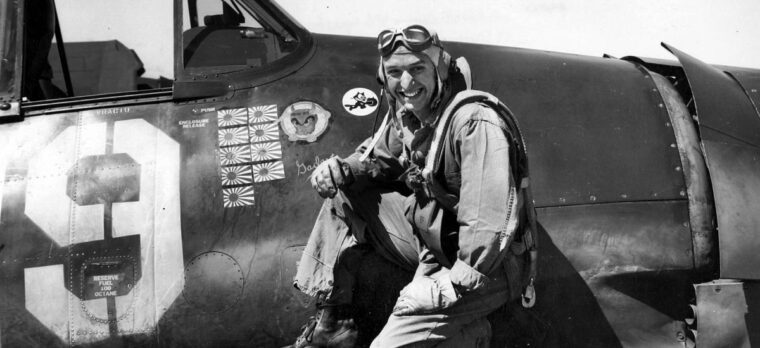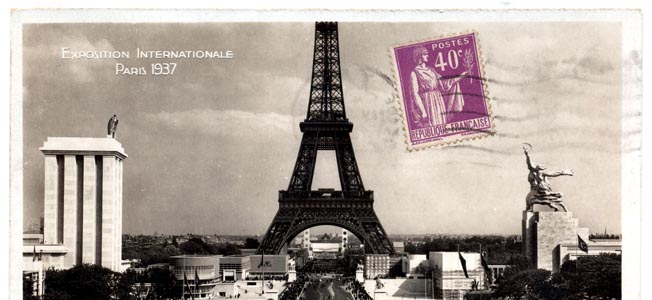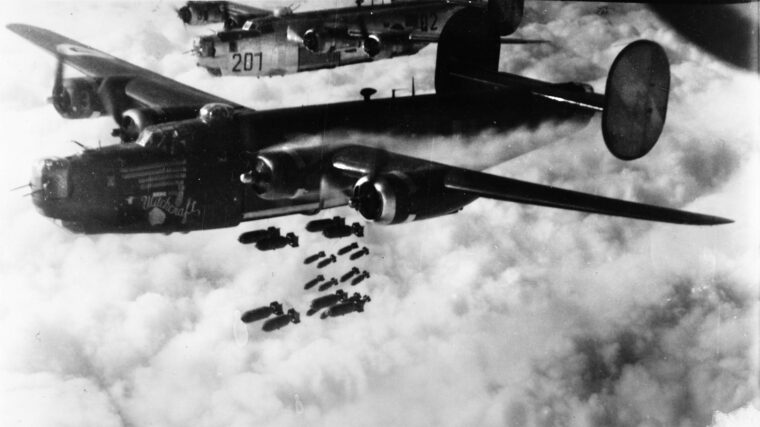
WWII
Building the Atlantic Wall
By Allyn VannoyThe popular image of Hitler’s Atlantic Wall (Atlantikwall) is one of massive bunkers and huge artillery pieces recessed in concrete casemates stretching the length of the Reich’s coastline. Read more


WWII
The popular image of Hitler’s Atlantic Wall (Atlantikwall) is one of massive bunkers and huge artillery pieces recessed in concrete casemates stretching the length of the Reich’s coastline. Read more

WWII
On June 23, 1944, Lieutenant (j.g.) Alex Vraciu posed for a photo with Vice Admiral Marc Mitscher, commander of Task Force 58, aboard the aircraft carrier Lexington. Read more

WWII
When American air ace Major John Mitchell led 16 Lockheed P-38 Lightning fighters on the longest combat mission yet flown (420 miles) on April 18, 1943, Mitchell’s target was Isoroku Yamamoto, the Japanese admiral considered the architect of the Pearl Harbor attack. Read more

WWII
The downwind approach of my Boeing 737 into Honiara International Airport goes over Iron Bottom Sound, with Savo Island off in the distance. Read more

WWII
On August 15, 1937, the Japanese Imperial Army bombed Nanking, the capital of China. These raids were unrelenting until December 13, when Japanese troops entered the conquered city. Read more

WWII
The Japanese strike on Pearl Harbor on December 7, 1941—a “Day of Infamy,” as President Franklin D. Roosevelt described it—left the American Pacific Fleet in almost total ruin, plunged the United States into World War II, and set off a controversy regarding the events that led up to the attack that is still being hotly debated. Read more

WWII
The 1937 Paris International Exposition once again centered world attention on the French capital that had previously been the stage for five world’s fairs, including the famous 1889 Paris Exhibition and the raison d’être for the construction of the Eiffel Tower, at 984 feet then the tallest structure in the world. Read more

WWII
Ask a member of the 467th Bombardment Group whom they hated most and the answer won’t be Göring or Hitler. Read more

WWII
Crowded in front of the television in Eli Rosenbaum’s office, his staff was taken with a giddy anticipation not often found in employees of the United States Department of Justice. Read more

WWII
George Catlett Marshall was the greatest American military man of his age. If the United States Army had kicked off the 20th century with the specific intent of constructing a chief of staff to lead it to victory in World War II, it could not have done a better job than what chance provided in the triumphs and travails over the 40 years that molded George Marshall. Read more

WWII
In March 1942, the Japanese juggernaut that had steamrolled across the Pacific during the early months of the war landed at Lae village at the southwestern corner of the Huon Peninsula of Papua New Guinea. Read more

WWII
Of the many highly successful fighter planes and bombers in the Allied arsenal during World War II, none was more versatile or singular than the Royal Air Force’s de Havilland Mosquito. Read more

WWII
“It is very difficult to be an openly declared, courageous Nazi today, and to express one’s faith freely,” read the editorial in the Völkischer Beobachter newspaper, which further added, “We have no illusions now.” Read more

WWII
The city of Nijmegen, in the southeastern part of Holland and about six miles from the Dutch-German border, is believed to be Holland’s oldest city, going back some 2,000 years. Read more

WWII
The Eighth Air Force—the “Mighty Eighth”—became the stuff of U.S. Air Force legend when its fleets of unprotected Boeing B-17 “Flying Fortress” heavy bombers flew massive air raids against the heavily guarded German industrial heartland during the period between the end of January through the middle of October 1943. Read more

WWII
Close to the northern end of the island of Tokashiki, the largest member of a tiny group of islands called Kerama Retto, located 15 miles west of Okinawa and hardly 400 miles from the Japanese home islands, Corporal Alexander Roberts and the rest of the 306th Regimental Combat Team rested for the night beneath the starry skies of the northern Pacific. Read more

WWII
The night of June 5, 1944, and the morning of June 6 were without a doubt some of the most pivotal hours in the history of the 20th century. Read more

WWII
The Commando role was born of the decision to mount vigorous raiding operations against occupied Europe as British forces were withdrawing from France in 1940. Read more

WWII
“The big day came and we moved off to our positions. Shortly a huge bombing raid commenced on the town of Wesel, followed by an artillery barrage which virtually shook the very ground under us. Read more

WWII
The early months of 1942 were dark days for the United States Asiatic Fleet. Much smaller than the Pacific Fleet, and equipped with mostly outdated surface ships, the fleet was in no way capable of winning a serious confrontation with the Imperial Japanese Navy. Read more